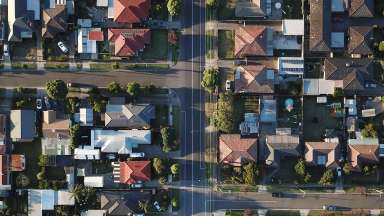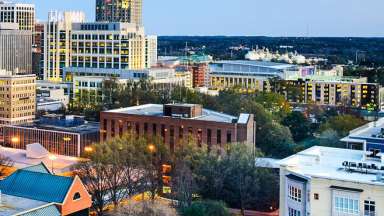Jump To:
Buildings & Energy Overview
Nearly half of Raleigh's community greenhouse gas (GHG) emissions come from the energy we use to heat, cool, and light our buildings and facilities. Efforts to transition our energy supply towards renewable sources and reduce energy use through efficient buildings are key to reducing emissions. Learn more about energy efficiency and renewable energy in Raleigh.
To learn more about the Raleigh’s progress towards climate action, please visit our larger City of Raleigh CCAP Data Dashboard. To learn more about climate action across Raleigh, check out the 2024 CCAP Implementation Report.
Solar
One important way to reduce GHG emissions across North Carolina is “greening” our energy supply grid. This means moving away from coal to cleaner renewables like solar and geothermal energy. The City has a long history of supporting solar energy across the Raleigh community. Initiatives such as SolSmart, Solarize the Triangle, and applying federal American Rescue Plan Act (ARPA) funding are all climate action project examples. Learn more about solar in Raleigh facilities and the community as well as how you could get solar at your home or business.
The data below shows total solar capacity in Raleigh provided through our partnership with the North Carolina Sustainable Energy Association. You can interact with the visual by clicking on specific years, or hovering over the bar columns to see specific data.
- In the past decade, total solar capacity in Raleigh has increased by over 500%.
- As of January 2023, 2,000 installations have the capacity to generate nearly 35 MW of solar power.
- This capacity is enough to power 5,000 detached homes, 7,000 townhomes, or 10,000 apartments annually.
- Residential installations make up nearly all installations (96%), but represent only 55% of total capacity.
- The City has 18 City facilities with solar technology, with capacity to generate over 3.4 MW of power.
- 11 facilities, including 9 Fire stations, use solar thermal technology to heat water for direct use.
Interested in learning more about the increase of solar and renewable energy in Raleigh? Check out the 2024 CCAP Implementation Report.
Geothermal & Other Renewables
While solar energy is the most viable renewable energy source in Raleigh, other renewable sources are evaluated when possible. Geothermal wells are another technology used for efficient heating and cooling.
The visual below shows geothermal installations across Raleigh, provided through our partnership with the North Carolina Sustainable Energy Association. You can interact with the data by using the toolbar in the upper right of the map.
- Currently, the greater Raleigh community has over 1,400 geothermal wells at approximately 325 locations.
- There are over 290 geothermal wells across all City facilities, including 80 wells at the Law Enforcement Training Center.
Check out our 2024 CCAP Implementation Report for more information about geothermal and other renewable energy sources.
Energy Efficiency
Addressing the energy used in buildings, particularly from heating and cooling, is important to reducing GHG emissions. Two of the primary rating systems for energy efficiency, Leadership in Energy and Environmental Design (LEED) and EnergySTAR, certify buildings that use design, materials, and technology to reduce energy use. In 2008, the Raleigh City Council adopted a policy that all new City-owned buildings (greater than 10,000 square feet) must be built to at least a LEED Silver standard. The City also seeks a higher rating whenever practical and funding is available.
The data below shows all LEED and EnergySTAR facilities located in the greater Raleigh area. You can interact with the data by using the toolbar in the upper right of the map. Data is provided by our partnership with the North Carolina Sustainable Energy Association.
- There are 135 commercial and municipal buildings that have received an EnergySTAR certification.
- 150 facilities have received a LEED certification in Raleigh, with 35% receiving a Gold certification level or higher.
- The City of Raleigh has 20 LEED certified facilities, with 5 receiving a Gold certification level or higher.
Interest in learning more about energy efficiency? Check out our 2024 CCAP Implementation Report.
Housing
Energy efficiency certifications like LEED or EnergySTAR are only one element of reducing energy use. Efficient housing “type” is also an important strategy to reduce energy and GHG emissions. Housing types like townhouses and apartments are typically smaller than single homes and share walls and/or ceilings. According to the Department of Energy, a townhouse produces about one-third the emissions of a single detached house, and an apartment produces less than half the energy than a single home.
Data below shows the total number of homes in Raleigh by type, in addition to total percentage by type since 2011 (source: American Community Survey Census). You can interact with the visual by clicking on specific years, or using the "Classification" filter below the visuals.
- Single family or “detached” housing has decreased since 2017, representing less than 10% of new construction.
- Nearly 4,200 apartment units were constructed in 2020 – 80% more compared to 2011.
- Raleigh continues to become a more densely populated city. The majority of Raleigh's households live in multifamily units (apartments, townhouses, duplex/tri/quad units).
- The trend towards multifamily construction is accelerating. Multifamily units represented 90% of all new construction in 2022.
As apartments and townhouses become more common and are coupled with energy efficiency strategies, energy use per household should decrease, resulting in lower energy costs for Raleigh residents in those housing types.
Interested in learning more about how housing classifications support climate action? Check out our 2024 CCAP Implementation Report.

